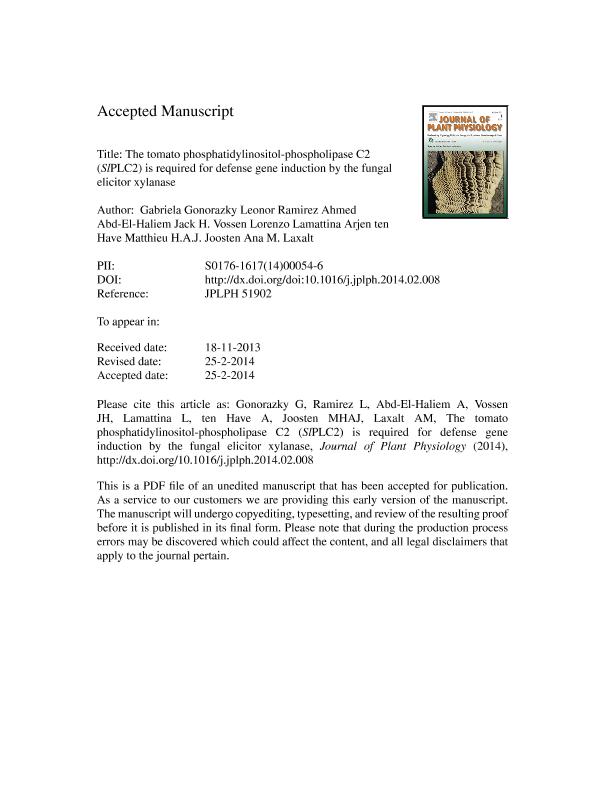Artículo
The tomato phosphatidylinositol-phospholipase C2 (SlPLC2) is required for defense gene induction by the fungal elicitor xylanase
Gonorazky, Ana Gabriela ; Ramírez, Leonor
; Ramírez, Leonor ; Abd El Haliem, Ahmed; Vossen, Jack H.; Lamattina, Lorenzo
; Abd El Haliem, Ahmed; Vossen, Jack H.; Lamattina, Lorenzo ; Ten Have, Arjen
; Ten Have, Arjen ; Joosten, Matthieu H. A. J.; Laxalt, Ana Maria
; Joosten, Matthieu H. A. J.; Laxalt, Ana Maria
 ; Ramírez, Leonor
; Ramírez, Leonor ; Abd El Haliem, Ahmed; Vossen, Jack H.; Lamattina, Lorenzo
; Abd El Haliem, Ahmed; Vossen, Jack H.; Lamattina, Lorenzo ; Ten Have, Arjen
; Ten Have, Arjen ; Joosten, Matthieu H. A. J.; Laxalt, Ana Maria
; Joosten, Matthieu H. A. J.; Laxalt, Ana Maria
Fecha de publicación:
07/2014
Editorial:
Elsevier Gmbh
Revista:
Journal Of Plant Physiology
ISSN:
0176-1617
Idioma:
Inglés
Tipo de recurso:
Artículo publicado
Clasificación temática:
Resumen
The tomato [Solanum lycopersicum (Sl)] phosphatidylinositol-phospholipase C (PI-PLC) gene family is composed of six members, named SlPLC1 to SlPLC6, differentially regulated upon pathogen attack. We have previously shown that the fungal elicitor xylanase rapidly induces nitric oxide (NO), which is required for PI-PLCs activity and downstream defense responses in tomato cell suspensions. Here, we show that all six SlPLC genes are expressed in tomato cell suspensions. Treatment of the cells with xylanase induces an early increase in SlPLC5 transcript levels, followed by a raise of the amount of SlPLC2 transcripts. The production of NO is required to augment SlPLC5 transcript levels in xylanase-treated tomato cells. Xylanase also induces SlPLC2 and SlPLC5 transcript levels in planta. We knocked-down the expression of SlPLC2 and SlPLC5 by virus-induced gene silencing. We found that SlPLC2 is required for xylanase-induced expression of the defense-related genes PR1 and HSR203J.
Archivos asociados
Licencia
Identificadores
Colecciones
Articulos(CCT - MAR DEL PLATA)
Articulos de CTRO.CIENTIFICO TECNOL.CONICET - MAR DEL PLATA
Articulos de CTRO.CIENTIFICO TECNOL.CONICET - MAR DEL PLATA
Articulos(IIB)
Articulos de INSTITUTO DE INVESTIGACIONES BIOLOGICAS
Articulos de INSTITUTO DE INVESTIGACIONES BIOLOGICAS
Citación
Gonorazky, Ana Gabriela; Ramírez, Leonor; Abd El Haliem, Ahmed; Vossen, Jack H.; Lamattina, Lorenzo; et al.; The tomato phosphatidylinositol-phospholipase C2 (SlPLC2) is required for defense gene induction by the fungal elicitor xylanase; Elsevier Gmbh; Journal Of Plant Physiology; 171; 11; 7-2014; 959-965
Compartir
Altmétricas



